Pennsylvania Avenue from the Treasury Through The Years
For over a hundred years it has been popular to take photos of Pennsylvania Avenue from the steps of the south portico of the Treasury Building. It is a magnificent view down America's "Main Street" with the Capitol sitting proudly at the far end. A survey of stereoviews and postcards (click on the images to see larger versions) shows the vast number of views that have been produced as well as the architectural changes that have occurred over the years.
We start before the birth of postcards, in the 1870s, with this stereo-graph card, showing the Avenue before any tall buildings had been built. On the right is a fine row of Federal-style townhouses, such as had lined both sides of Pennsylvania Avenue in the early part of the 19th century. This row would be demolished in the late 1880s and so doesn't appear in any of the postcards. The house nearest us on the corner was Mrs. Suter's Tavern in 1814, where the British made their temporary headquarters while burning the White House. On the left are more federal townhouses; the one toward the middle of the block will last longer than the one nearest us. Past those buildings are the faint outlines of the original Willard Hotel, built in 1818 and enlarged in the 1850s. This is the hotel where Lincoln stayed when he arrived in Washington for his inauguration. It would be torn down in 1900 to make way for the much larger, grander hotel that still stands there today. The old Willard is still visible on the left side of the next stereoview, circa 1880, which also shows an early horse-drawn trolley car turning from 15th Street on to the avenue.
This next stereoview, from the 1890s, also shows the old Willard still standing but adds a much more bustling street scene on Pennsylvania Avenue. The old horse-drawn streetcars had been replaced with electric ones by the time this shot was taken.
![]()
Next are a series of cards from the early 1900s--the golden age of postcards--that show the variety of colors and style that were produced, all showing the same scene. First, from 1905, is this double-width, folded postcard from 1905, seen above, that offers a panoramic view. The Corcoran office building (1875) is on the left. The building became the art center of Washington in the 1880s, with many prominent artists keeping their studios there. It has replaced the low federal buildings on the corner, only one of which remains in the center of the block. Just to the right is the newly-built (1901) Willard Hotel, designed by New York architect Henry Janeway Hardenbergh, the architect of the Waldorf-Astoria. On the right hand side a lot of change has occurred as well. Starting in the distance and moving toward us, we see the Old Post Office building with its iconic tower, constructed in 1898, just to the right of the Capitol. Most of the Post Office building itself is hidden behind the Southern Railway Building, originally built in 1871 and enlarged in 1898 with the mansard tower visible here. This ornate Renaissance Revival building burned in 1916 and was torn down shortly thereafter. At the far end of the block closest to us is another towered building, the meeting hall of the Grand Army of the Republic. In the middle of the block is Chase's Theater, a popular venue that featured "polite vaudeville." Its successor would be the Keith's Theater on 15th Street a block north. At the near corner is the Hotel Regent.
This stereoview is from the same era, but with a little added human interest:
The following nighttime view is from 1905-1910 and shows the same buildings as the panoramic card and the stereoview.
The next card, from about 1912, has an important difference, although it may take a moment to spot. In 1911, the Raleigh Hotel, located on the left-hand side of the Avenue at 12th Street, was significantly enlarged. It now appears prominently in the middle distance in this view.
In the following view from the 1920s, the major change is that the Corcoran office building on the left has been replaced by the Hotel Washington, built in 1917. The small white building next to it is a Child's Restaurant, built in 1913, part of a New York chain of lunchrooms. On the opposite side, a new, blander Southern Railway Building has replaced the towered edifice that had burned in 1916.
Our last card dates from the 1940s, and it shows how the Avenue looked after the block on the right-hand side had been cleared of buildings in 1931. This open space would eventually become Pershing Park. Beyond it on the right, Federal Triangle has taken shape, with the Commerce Department building partially visible.
And here's a recent photo from roughly the same position. The Treasury grounds are not generally open to the public anymore, so this shot was taken from the sidewalk.
We start before the birth of postcards, in the 1870s, with this stereo-graph card, showing the Avenue before any tall buildings had been built. On the right is a fine row of Federal-style townhouses, such as had lined both sides of Pennsylvania Avenue in the early part of the 19th century. This row would be demolished in the late 1880s and so doesn't appear in any of the postcards. The house nearest us on the corner was Mrs. Suter's Tavern in 1814, where the British made their temporary headquarters while burning the White House. On the left are more federal townhouses; the one toward the middle of the block will last longer than the one nearest us. Past those buildings are the faint outlines of the original Willard Hotel, built in 1818 and enlarged in the 1850s. This is the hotel where Lincoln stayed when he arrived in Washington for his inauguration. It would be torn down in 1900 to make way for the much larger, grander hotel that still stands there today. The old Willard is still visible on the left side of the next stereoview, circa 1880, which also shows an early horse-drawn trolley car turning from 15th Street on to the avenue.
This next stereoview, from the 1890s, also shows the old Willard still standing but adds a much more bustling street scene on Pennsylvania Avenue. The old horse-drawn streetcars had been replaced with electric ones by the time this shot was taken.
Next are a series of cards from the early 1900s--the golden age of postcards--that show the variety of colors and style that were produced, all showing the same scene. First, from 1905, is this double-width, folded postcard from 1905, seen above, that offers a panoramic view. The Corcoran office building (1875) is on the left. The building became the art center of Washington in the 1880s, with many prominent artists keeping their studios there. It has replaced the low federal buildings on the corner, only one of which remains in the center of the block. Just to the right is the newly-built (1901) Willard Hotel, designed by New York architect Henry Janeway Hardenbergh, the architect of the Waldorf-Astoria. On the right hand side a lot of change has occurred as well. Starting in the distance and moving toward us, we see the Old Post Office building with its iconic tower, constructed in 1898, just to the right of the Capitol. Most of the Post Office building itself is hidden behind the Southern Railway Building, originally built in 1871 and enlarged in 1898 with the mansard tower visible here. This ornate Renaissance Revival building burned in 1916 and was torn down shortly thereafter. At the far end of the block closest to us is another towered building, the meeting hall of the Grand Army of the Republic. In the middle of the block is Chase's Theater, a popular venue that featured "polite vaudeville." Its successor would be the Keith's Theater on 15th Street a block north. At the near corner is the Hotel Regent.
This stereoview is from the same era, but with a little added human interest:
The following nighttime view is from 1905-1910 and shows the same buildings as the panoramic card and the stereoview.
In the following view from the 1920s, the major change is that the Corcoran office building on the left has been replaced by the Hotel Washington, built in 1917. The small white building next to it is a Child's Restaurant, built in 1913, part of a New York chain of lunchrooms. On the opposite side, a new, blander Southern Railway Building has replaced the towered edifice that had burned in 1916.
Our last card dates from the 1940s, and it shows how the Avenue looked after the block on the right-hand side had been cleared of buildings in 1931. This open space would eventually become Pershing Park. Beyond it on the right, Federal Triangle has taken shape, with the Commerce Department building partially visible.
And here's a recent photo from roughly the same position. The Treasury grounds are not generally open to the public anymore, so this shot was taken from the sidewalk.


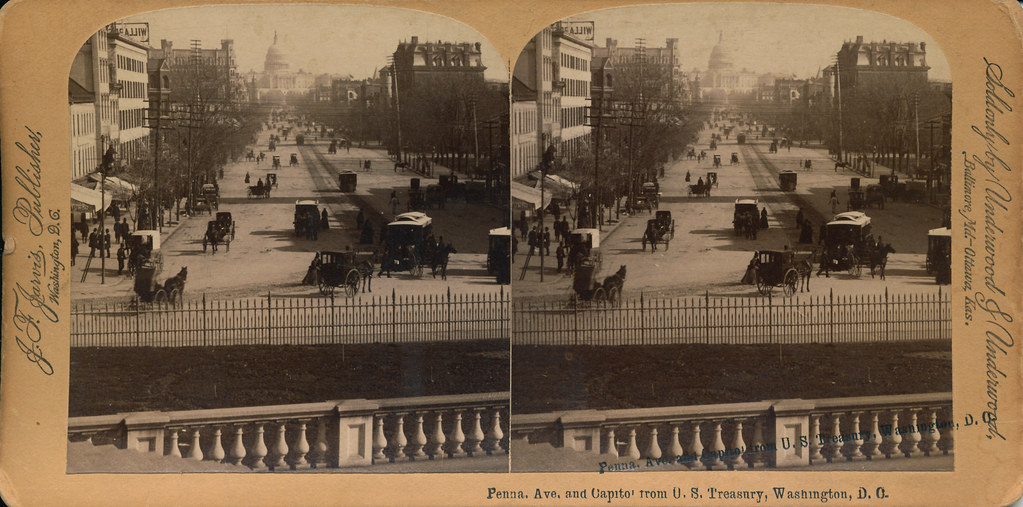

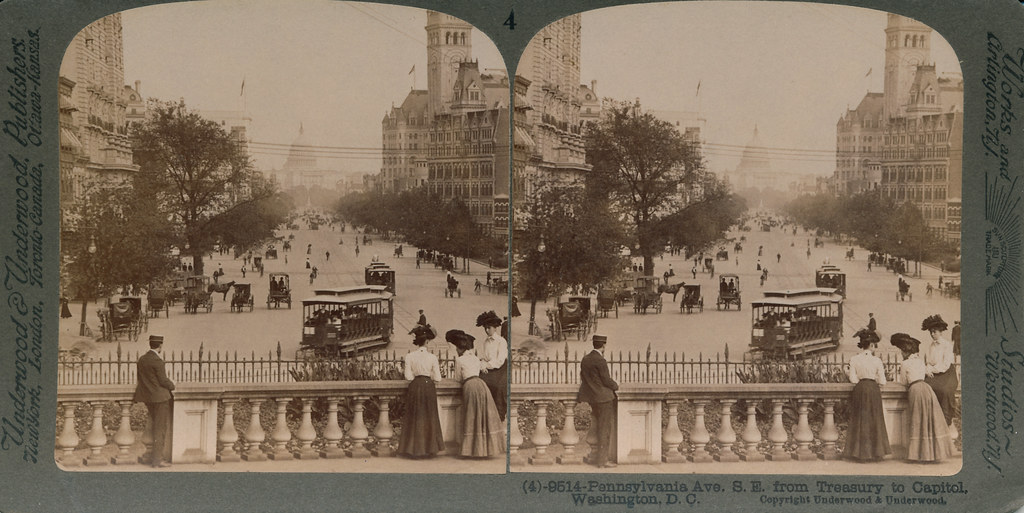
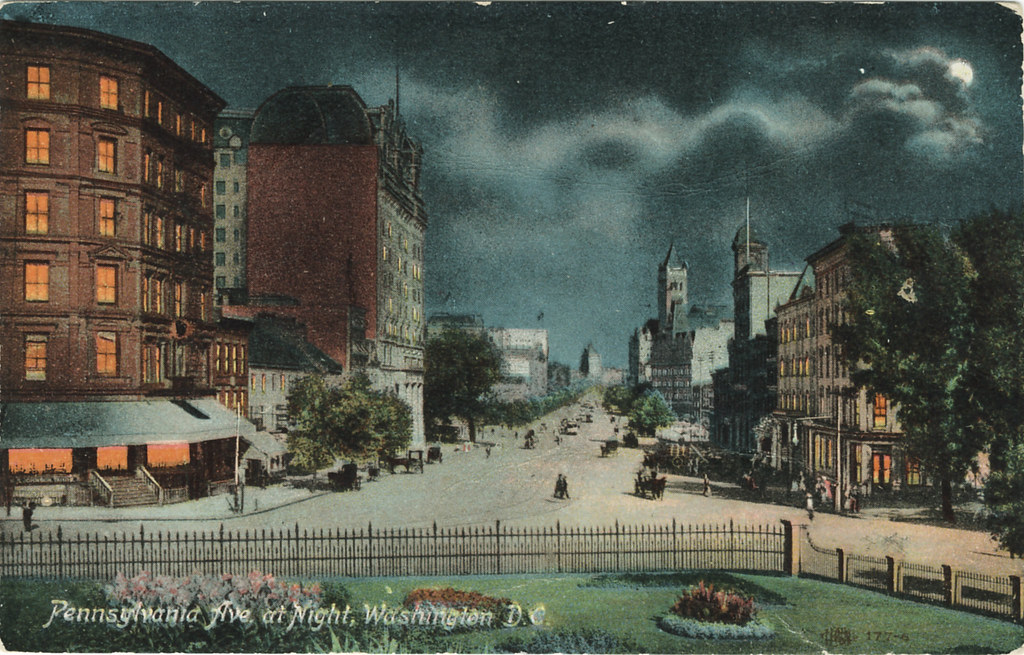
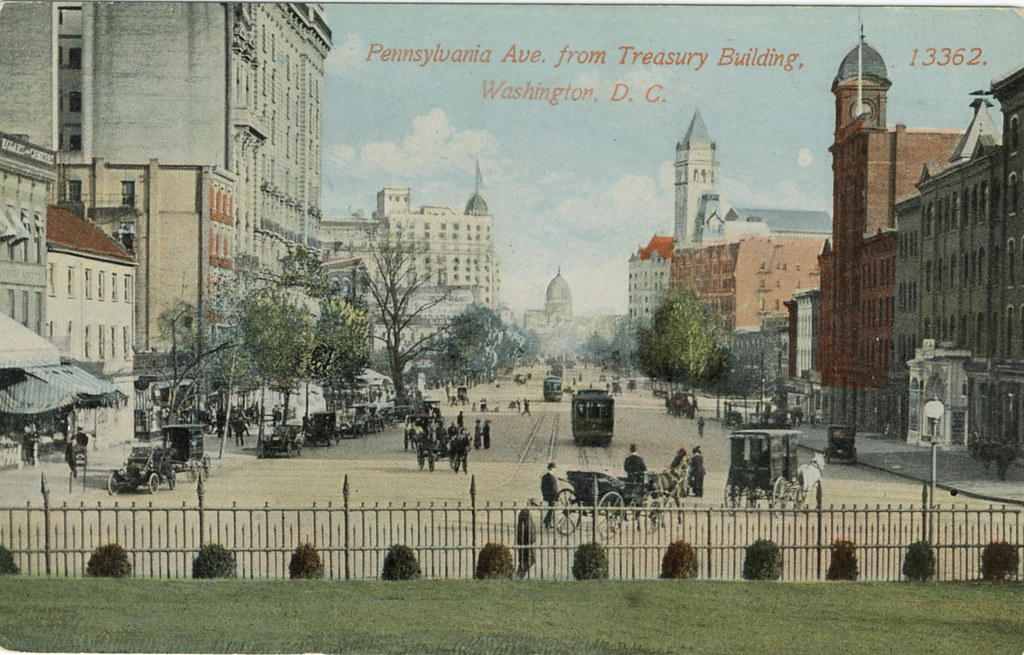
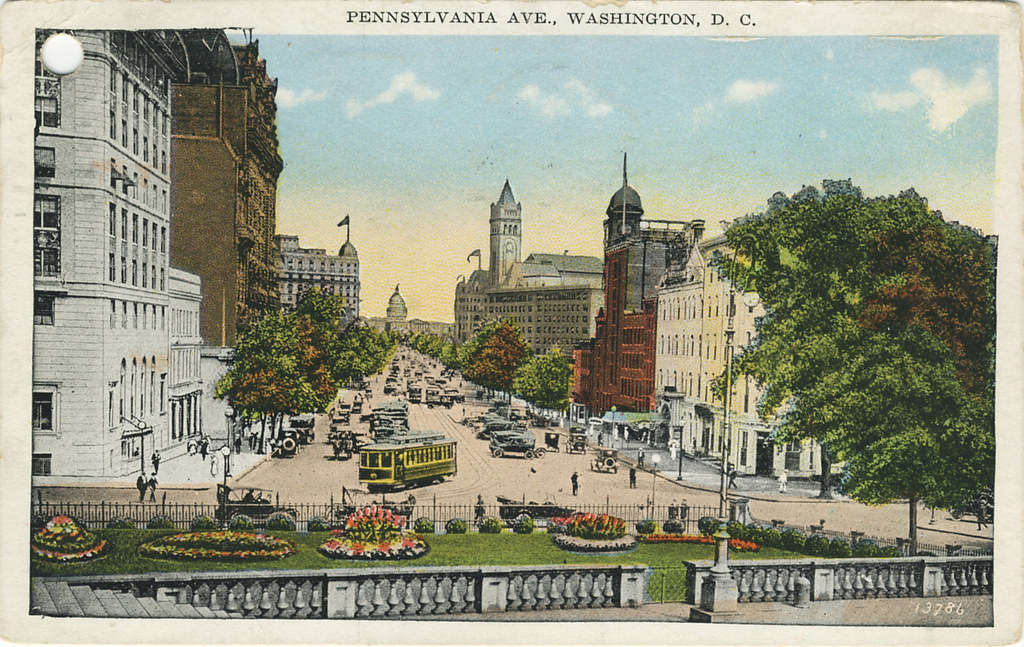




wow, that last shot brings it all into perspective. it went from an iconic, expansive view taking up your field of vision to just another crosswalk.
ReplyDeleteNotice in the three tinted photos from 1905 to 1910, the first and third are actually the same photograph, differently tinted. Everything on the street is in the same position; only the flags on the right seem to have moved.
ReplyDelete